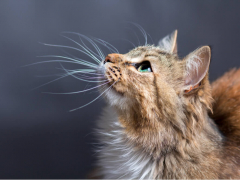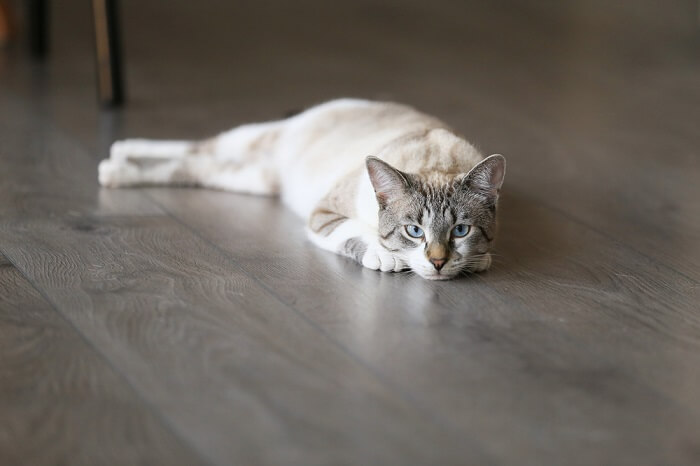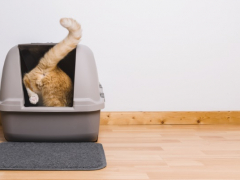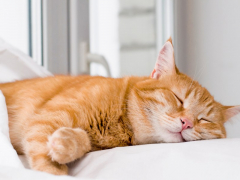
Your cat is lounging in the windowsill, looking perfectly serene. Then, all of a sudden, she perks up, jumps off the windowsill, and runs screaming through your home.
What on earth just happened?!
No, your cat didn’t just get spooked by a ghost. She probably just had an episode of a rare and bizarre disease called feline hyperesthesia syndrome (FHS).
What Is Feline Hyperesthesia Syndrome?
Hyperesthesia is defined as abnormally increased skin sensitivity. FHS is frustrating for cats and cat parents alike. It is not curable but can be managed with medication and behavioral changes.
Feline Hyperesthesia Syndrome Causes and Risk Factors
FHS is also known as ‘rippling skin syndrome’ and ‘twitchy cat syndrome.’ Certain cat breeds—Persian, Siamese, Abyssinian, and Burmese—are genetically predisposed to FHS. Although any age of cat can be affected, the first episode of FHS usually appears between ages 1 and 5. Males and females are equally affected.
Cats who live in a high-stress environment or tend to be nervous or hyperactive might be at an increased risk of developing FHS.
Although the exact cause of FHS remains unknown, there are a few theories about this disease’s origins. One theory is that FHS is a form of epilepsy. Another theory is that it’s a form of obsessive-compulsive disorder.
Because certain breeds are predisposed to FHS, genetics are also thought to play a role. An additional theory is that FHS is caused by abnormal electrical activity in different parts of the brain.
Feline Hyperesthesia Symptoms
FHS symptoms are widely variable. The syndrome’s episodes typically occur at dawn or dusk. These episodes range from a few seconds to a few minutes, with variable frequency. Often, a cat parent cannot stop an episode once it starts, which can be very distressing.
The spine and tail are the most frequently affected areas of the body. Symptoms can start as mildly unpleasant but quickly progress to irritating and debilitating.
Symptoms of Feline Hyperesthesia include:
- Seizures
- Dilated pupils
- Skin twitching
- Self-mutilation
- Attacking the tail
- Pain when petted
- Licking or biting the paws
- Vacant staring into space
- Running and screaming through the house
- A sudden stop in normal behavior, with a startled look
- Sudden and drastic behavioral changes (e.g., increased or decreased aggression, hyperactivity)
Itchy skin conditions like flea allergies can worsen the symptoms. Also, many of these symptoms are seen with other health conditions, so the presence of these symptoms does not automatically indicate FHS.
Feline Hyperesthesia Syndrome Diagnosis

FHS is a diagnosis of exclusion, meaning that other diseases need to be ruled out before FHS can be diagnosed. The diagnostic process for FHS is lengthy. If your cat has any of the symptoms listed above, be prepared for your cat to undergo a lot of testing before your veterinarian confirms an FHS diagnosis.
First, your veterinarian will need a history of the symptoms:
- What symptoms you’ve observed
- When the symptoms started
- Severity of symptoms
- Frequency and duration of FHS episodes
If possible, show your vet a video recording of one of your cat’s FHS episodes.
If your veterinarian suspects FHS, they will start ruling out other conditions that could explain your cat’s symptoms. Basic diagnostic testing usually begins with a physical exam, bloodwork, urinalysis, skin tests, a neurologic examination, and spinal x-rays.
Below are the disease categories that your veterinarian will rule out:
Dermatologic
Common itchy skin conditions include flea allergy dermatitis and atopic dermatitis. Your veterinarian will first prescribe flea control and anti-inflammatory medications (corticosteroids) to try to manage the itching. Your vet might also recommend omega-3 fatty acid supplements.
Neurologic
If symptoms persist after treating the skin, your vet will then consider neurologic conditions, like epilepsy and spinal disease. This will require spinal x-rays and a neurologic exam. Your vet may refer you to a veterinary neurologist.
Musculoskeletal
If your cat still isn’t getting better, then painful orthopedic conditions like osteoarthritis will need to be ruled out. Pain medication and complementary therapy (acupuncture, massage) may be tried.
If all of these disease categories have been ruled out, FHS will become the likely cause of your cat’s symptoms.
FHS Treatment
Once your veterinarian has made the FHS diagnosis, it will be time to devise a treatment plan to eliminate your cat’s discomfort and improve her quality of life. Behavioral changes and medication are used for treatment. Treatment plans need to be personalized for each affected cat.
Behavioral Changes

If you want to sleep better, first you have to figure out what is causing your cat’s stress
Behavioral changes, such as those listed below, can reduce your cat’s stress and anxiety, both of which can trigger FHS episodes.
The following adjustments may help:
- Redirect your cat away from stressful situations
- Create and maintain a normal daily routine for feeding and playtime
- Eliminate competition for resources in a multi-cat household (e.g., multiple safe spaces, separate feeding locations, multiple litterboxes)
- Provide environmental enrichment, such as hiding treats around the house, engaging in interactive playtime, and providing cat-friendly structures like windowsill perches
Medication
Behavioral modifications might not be enough to adequately manage FHS. This is where medication comes in.
Currently, there are no FDA-approved medications specifically for FHS.
Fortunately, other medications can be used to manage the syndrome’s symptoms:
- Specific serotonin reuptake inhibitors: These drugs make sure that there’s plenty of serotonin, a neurotransmitter, in the brain. Serotonin regulates mood and can even reduce a cat’s obsessive-compulsive behaviors. Examples include Prozac® and Zoloft®.
- Anti-seizure medications: If your cat’s FHS episodes involve seizures, then anti-seizure medications like phenobarbital and gabapentin can reduce the seizure frequency.
These medications are typically started at a low dose. Monitor your cat’s response to the medications so that your veterinarian can know whether to make dosage adjustments. Your vet will perform periodic blood tests to evaluate your cat’s liver and kidney function.
Ideally, your cat will be able to be weaned completely off medication, but some cats will need lifelong medical therapy to control FHS.
Final Thoughts
FHS is a complex and frustrating condition. Left unmanaged, FHS can be debilitating for your cat and significantly decrease their quality of life.
If you notice symptoms of FHS in your cat, don’t delay in scheduling a veterinary appointment. Work closely with your veterinarian to develop a management plan to relieve your cat’s symptoms and restore her normal quality of life.







